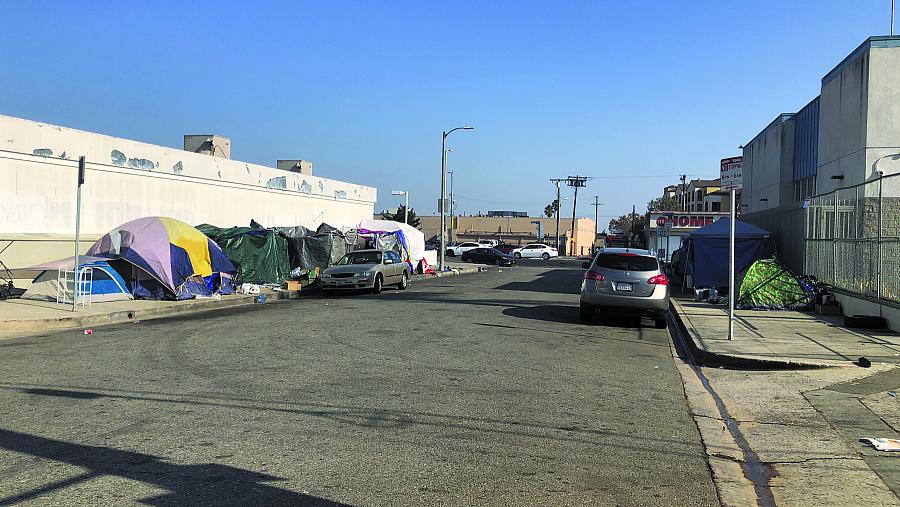New California Medicaid program seeks to better implement services for mentally ill homeless

A homeless encampment on Western Avenue in Los Angeles.
(Photo via Merdies Hayes)
For years, homelessness in Los Angeles County has been a familiar news story.
But there is more urgency today in how to address the issue of mental illness among the homeless population. The subject has steadily gained traction not only in the Southland, but throughout the state and nationwide. Los Angeles County hosts roughly 60,000 homeless persons, many of whom suffer from any number of forms of mental illness, ranging from post-traumatic stress disorder, bipolar disorder, schizophrenia, psychosis, and so on.
Officials from county health, law enforcement and local office holders no longer see this issue as a “What to do with them?” concern (i.e. warehousing people with a mental illness in the county’s Twin Towers jail) but instead to seek a pathway toward a more compassionate — and effective — strategy of treatment.
Two years ago, the Los Angeles County Board of Supervisors launched a pilot program to get homeless people gravely disabled by mental illness into treatment, even involuntarily, if necessary to save their lives. The Homeless Outreach and Mobile Engagement (HOME) teams would provide critical treatment interventions for people experiencing homelessness and struggling with mental illness. Included were mental health psychiatrists, counselors, nurses, social workers, substance abuse counselors and medical caseworkers to make evaluations “on the street” and offer voluntary crisis intervention services and access to resources, most notably housing and health treatment.
Under the program, the term “gravely disabled” means that someone cannot provide for their basic needs (such as food, clothing and shelter) because of a mental disorder. The program was initiated by the Los Angeles County Department of Mental Health (DMH), which had long advocated for more dramatic interventions. The department fully endorsed the Board’s decision.
These are drastic measures undertaken to prevent further tragedy to the individual and the public at large. Notwithstanding the ravages of pandemic, last year nearly 1,000 homeless persons died on the streets. The Department of Mental Health found that a significant number of these deaths were due to preventable or treatable medical conditions.
“In my opinion, we’re reaching an inflection point,” said Dr. Jonathan Sherin, director of the Department of Mental Health. “It’s not just about the individual, it’s about the collective public safety. It’s a public health emergency.” Sherin last summer drew an interesting comparison between “open-air asylums” (streets) and “closed-air asylums” (jails). He would describe the peril of people “languishing in the streets” and dying not only from overdoses, but also from traffic accidents: Some individuals have deliberately walked into oncoming traffic.
There have been policy failures related to homelessness in practically all county municipalities. As a result, citizens have shown increased animosity not only toward the unhoused, but toward local governments. This is where a new and more innovative program may be of significant help. CalAIM, short for California Advancing and Innovating Medi-Cal, is a new program designed to transform the 57-year-old state-federal Medi-Cal program. Among its aims:
1. Identify and manage comprehensive needs by improving “whole person” care approaches and social drivers of health.
2. Improve quality outcomes, reduce health disparities, and transform the delivery system through “value-based” initiatives, modernization and payment reform.
3. Make Medi-Cal a more consistent and “seamless” system for enrollees to navigate by reducing complexity and increasing flexibility.
Part of the motivation of CalAIM is to leverage Medicaid itself as a tool to help address complex challenges. These include behavioral health access and the health needs of homeless persons suffering from mental illness. A “person-centered” approach is reportedly central to CalAIM. Assessments of each enrollee’s health risks and health-related social needs will include a focus on wellness and prevention.
In-person engagement is the best path forward to meet Medi-Cal enrollees where they live, seek care and how they may choose to access services. CalAIM also includes behavioral health incentives, with the goal of standardizing access to services for enrollees with serious mental health needs.
A challenge to CalAIM is to identify and connect with homeless people who can qualify for Medi-Cal. Many of them lack a permanent address, have a jail record, and are struggling with sobriety. Such issues may disqualify certain individuals for Medi-Cal services. Early review of the program indicates it can improve access to appropriate institutional care for those who both desire and need it. Promoting higher quality care in institutional settings — and addressing equity in California’s long-term care services — will reportedly be at the forefront of CalAIM’s application to its clients.
The first reforms were implemented in January. Additional reforms are scheduled to be phased in through 2027. Work is underway to ensure a smooth transition from existing programs to CalAIM once the initial reforms are finalized and approved.
Sherin admits that there are “no easy solutions” to care for the mentally ill homeless population, citing “decades of being negligent.” Like other county leaders, however, he believes the new program is a positive step forward.
“We have to engage the individual and place resources first,” Sherin said. “We need to look for more humane ways of working with the mentally ill. We need to give people the chance to live full lives.”

